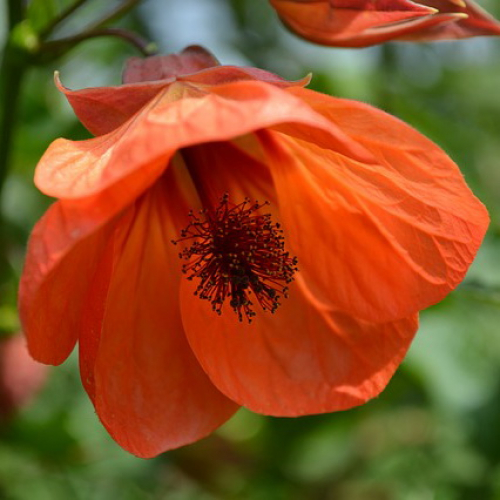Indoor plants Abutilon

Description
Special Features of Abutilon
Abutilon is a genus in the mallow family Malvaceae, with more than 100 species (according to some sources, 150 or even 400!) of evergreen perennial and annual grasses, dwarf shrubs, and bushes, sometimes even medium-sized trees. In their natural habitat, they grow in the tropics and subtropics of America, Australia, Asia, and Africa, while some species grow in areas with a temperate climate.
About 10 species that are native to South America, mostly Brazil, are grown as ornamentals and have a lot of varieties and hybrids. Plant growers collectively refer to them as to a Flowering Maple. They are mostly cultivated as houseplants and classified to the beautifully flowering category. Here is a short list:
- Abutilon vitifolium is a shrub 1.5 metres tall and 2 metres across with lavender flowers 5 centimetres in diametre.
- Abutilon x hybridus, famous for its Bella mixed (compact shrubs about 40 centimetres tall with large flowers in the pastel shades of apricot, pink, and yellow up to 8 centimetres in diametre) and Large Flowered mixed varieties (50-80 centimetres tall with abundant flowers, though typically funnel-shaped and small sized (up to 4 centimetres), but amazing because of a great range of colours).
Varieties of the both species can be grown from seed.
- Abutilon darvinii was used to create Abutilon x hybridus and a group of large-flower hybrids with velvet dark green leaves: Donna (salmon pink flowers with pale veins), Eric Lilac (dark red flowers), Eric Roze (light pink flowers with dark pink veins), Laura (orange yellow flowers, pinkish red at edges), Pink Niedorp (pink flowers with dark pink veins), and Red Princess (shiny red flowers).
- Abutilon megapotamicum is very good for container growing, hanging baskets, and garden vases. It grows rapidly. Sometimes, its unusual flowers similar to Chinese lanterns decorate the plant up to the first frosts. When the temperature drops to 5 ° C, move the plant indoors.
- Abutilon pictum also known as Abutilon striatum and commonly referred to as Redvein Abutilon has yellow splashes on the leaves and bright veins on the flowers. This colour results from a specific virus and only maintained with vegetative reproduction, but not with propagation from seed.
- Abutilon sellovianum is a shrub that can reach the height of two metres even if kept indoors. The orange bell-like flowers are adorned by dark pinkish veins.
- Abutilon suntense is intended for winter gardens. It can reach 1.8 to 4 metres in height and has huge lilac flowers 10 centimetres in diametre.
If we summarize the partial descriptions and extract the essence, we get the following generic characteristics:
a) Flowering of Abutilon is long and abundant. The flowers have lots of stamens and pistils. They are bell-shaped and either single or double. Bright corolla petals can be different colours (mentioned above plus white, burgundy, or golden).
b) Abutilon is notable not only for it flowers but also for its leaves, soft, downy, variegated, or plain.
c) The plant is quickly forms a sprawling shrub producing new growth, each shoot budding and blooming in due time.
d) With a good care, Abutilon grows quickly and easily.
The Secrets to Successfully Growing Abutilon
Indoor Abutilon is a tub plant quickly getting too large to be grown on a windowsill. It requires a free space. Choosing a new location, remember that Abutilon loves light and requires direct sunlight for a few hours a day. In the winter, place the plant in a bright room, preferably near the south-facing window but not too close to the heating appliances.
In the spring and summer, Abutilon requires thorough watering. When the soil is not kept moist, Abutilon can drop buds and leaves. Empty the drainage tray after watering.
In the autumn and winter (October to February), watering should be moderate and only limited to slight moistening of the soil. Misting the leaves as well as supplementary lighting in the winter might be needed.
The best temperature for Abutilon is about 20 ° C in the summer and 10-16 ° C in the winter.
Feed the plant once a fortnight from spring to autumn using household fertilizers for indoor plants.
Repot Abutilon every spring. It is recommended to use slightly acidic soil consisting of loam, leaf mold, humus, peat, and sand at 1:1:1:1:1. It is better when a new pot is only a bit larger than the old one, because the plant blooms better if it is rootbound. Long roots can be cut.
If you propagate Abutilon by tip cuttings, plant them in the soil at 20-25 ° C. Seeds germinate in 2 weeks at 20 ° C and seedlings bloom 4 months later.
If you want to form a magnificent crown, prune the quick-growing shoots and cut them off in half in the late winter.
Potential Problems
Abutilon is quite unpretentious but it does not like to be moved quickly in the bright light and it does not tolerate drafts.
Abutilon may drop leaves (bottom leaves first) if the soil dries off, with insufficient light or incorrect temperature.
The soft leaves are susceptible to whiteflies, spider mites, aphids, and scale insects. Control pests by misting tobacco or soap solutions. Carefully remove scale insects with a cotton stick.







 334
334







